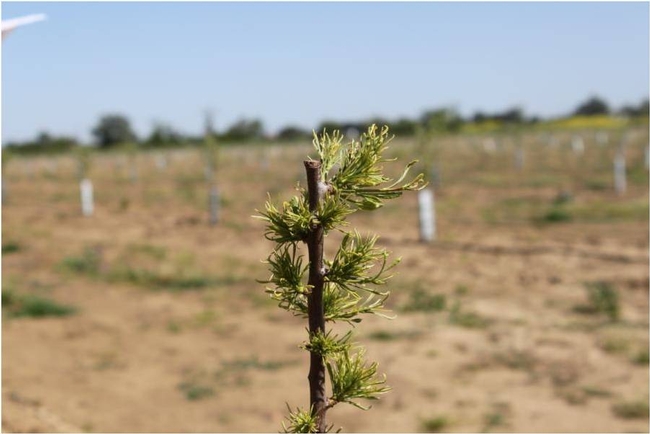May 8, 2011
I went on a farm call last week (early May) in response to a suspected herbicide injury issue in a recently replanted almond orchard. The grower had applied a tankmix of glyphosate and Goal as a preplant burndown treatment a week or so before planting. In some areas of the field, the first leaves were badly stunted and yellowed and the grower and PCA wondered if was caused by the preplant treatment.

Although the symptoms are pretty classic for glyphosate exposure (stunted leaves, shortened internodes or "witches brooming", and chlorosis of the newest growth), this injury didn't make sense with the herbicide application in this field. There was not an obvious pattern of injury spatially across the field; however, the symptoms were only in one variety (nonpariel and the two pollinators were on the same rootstock).
I'm fairly certain that the symptoms are from glyphosate exposure but is not from the preplant application. Glyphosate is tied up pretty strongly to soil (especially to organic matter and clay particles) and this orchard has a fairly heavy soil for the area. Instead, what I suspect happened is that the affected trees probably were exposed to glyphosate drift the previous fall (in the nursery in this case, since they were replants). The herbicide was taken in by the green bark and/or foliage but may not have shown symptoms if it was late enough in the fall. The glyphosate, which is fairly stable in plants, was stored in the tree until spring and the symptoms became obvious as new growth resumed this spring.
A couple of interesting points about glyphoste:
1. it is tied fairly tightly to soil - significant exposure via root uptake is very rare.
2. it is pretty stable in plant tissue. In soil it is broken down primarily by microbial action but this would be slow or nonexistent in dormant (and cold stored) plants.
3. the greatest concentration of the target enzyme for glyphosate (EPSPS) is in new tissues where the most synthesis of new cells is occuring. This area is also where the greatest use of stored carbon and new photosynthates are being used.
4. glyphosate moves in the phloem of plants (just like photosynthates) and will be found at the highest concentration in the meristematic regions (like shoot tips and new buds). That's why you usually see glyphosate damage in the youngest tissue first.
Will this injury kill these trees? Probably not - but it will significantly delay their early growth. Tom Lanini and I did a small project last year where we appled glyphosate to young trees in the fall. When they leafed out in the spring they look just like this. At lower rates, the trees mostly recovered by late spring but at higher rates they were still stunted in late summer. A year later, the growth looks normal (but the growth of the worst trees is behind).
A local lab is running samples to confirm that this is indeed from glyphosate. If it is glyphosate and not some other problem, I suspect that the grower will replant the affected trees because these were new transplants and it is still early in the spring. If it was later in the year (too late to replant successfully), he might wait and see how they recovered because they would be delayed in growth.
Take care,
Brad